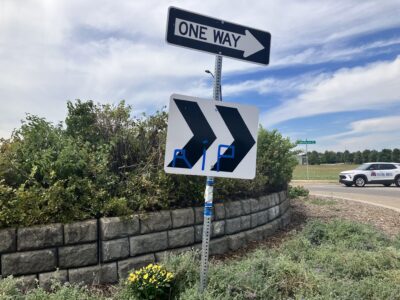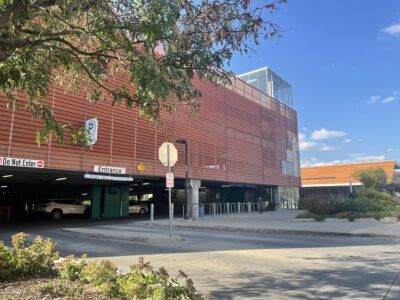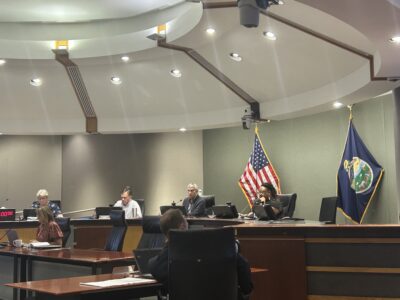Group that helped return prayer rock to the Kaw Nation wants more input on how to honor Indigenous people at Robinson Park

photo by: Bremen Keasey
Sydney Pursel (far right) gives a presentation about the work done by the Sacred Red Rock Project in relocating a rock sacred to the Kaw people back to Kaw land. She and the project are asking the public for more feedback on potential changes to Robinson Park — the downtown Lawrence park where the rock was previously located.
Community members shared their input on possible changes to downtown Lawrence’s tiny Robinson Park — including changing its name or adding an Indigenous monument — at an open house hosted by the Sacred Red Rock Project on Thursday.
The group wants public feedback on what the park’s future should be now that the prayer rock that once stood there, Iⁿ’zhúje’waxóbe, has been returned to the Kaw Nation. And they’re especially hoping to find a way to honor Indigenous tribes.
Iⁿ’zhúje’waxóbe, the 28-ton red quartzite boulder, was taken from the Kaw’s traditional homelands nearly a century ago and made into a monument to Lawrence’s white settlers in the park, which is across the street from City Hall. Last year, the Sacred Red Rock Project group led the effort to remove the rock from the park and return it to the Kaw, and it was installed in late March of this year at the Kaw’s Allegawaho Heritage Memorial Park just outside of Council Grove.
Sydney Pursel, the curator for public practice at the University of Kansas’ Spencer Museum of Art, led the presentation about future ideas for Robinson Park at Thursday’s open house. Pursel, one of the leaders of the Sacred Red Rock Project, added that the group is looking to narrow down the ideas it received from the public as it crafts a plan for the City Commission to consider. The project offered a public survey, which is available online, to give feedback on the ideas.
Some of those ideas include renaming the park, creating safer ways for residents to reach the park and building a monument to honor Indigenous peoples. Pursel felt that would be the “easiest place to start.”
Robinson Park is named after a white Kansas settler — Charles Robinson, the first governor of the state of Kansas — and leaders of the Sacred Red Rock Project said the most common feedback they heard was changing the name. Three options under consideration are the Kaáⁿ’ze Heritage Park, which uses another name for the Kaw Nation, from which Kansas takes its name; Indigenous Peoples Park; or Chief Lucy Tayiah Eads Park, which celebrates the first female tribal chief of the Kaw Nation.
The group also is asking for recommendations on putting some kind of monument for the Kaw on the site. Pursel said Kaw Nation elders who spoke with the project team said that after the removal of the prayer rock, the void left by the rock “must be filled.” Pursel said some of the ideas floated so far have included statues, a memorial tree or a meditation garden.
Additionally, the project wants to consider ways to make the park more accessible to the public. Because it’s positioned between the intersections that lead to the Kansas River bridge, it can be unsafe for pedestrians to get there. To remedy this, Pursel said the group is considering connecting it with the Lawrence Loop trail or adding pedestrian bridges or ways to access the park from the river.
“If this is a site where people want to gather, we want them to access it safely,” Pursel said.
Another suggestion from the public that was previously addressed was the idea of giving the land back to the Kaw Nation. Jim Pepper Henry, a former vice chairman of the Kaw Nation and the tribe’s cultural presentation officer, said that although the idea was appreciated, being gifted the one-acre site would be impractical for them. Pepper Henry said owning the land would create extra expenses, including maintenance, liability insurance and property taxes.
Pepper Henry said the Kaw Nation was supportive of leaving the land to the public trust, and he added that changing the name to honor Chief Lucy Tayiah Eads was something he would support, personally.
Pursel said whatever the future of the park, the project would work with the Kaw Nation on any proposal that would be given to the city. Pursel said the group hopes the official proposal can be given to the City Commission in December of this year.






